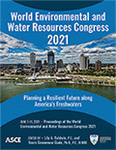Analysis and Modeling of Frozen Ground and Soil Temperature in North Dakota
Publication: World Environmental and Water Resources Congress 2021
ABSTRACT
Long periods of snow-covered frozen ground affect the generation of surface runoff by altering the infiltration process. Physically based approaches to identify frozen ground are relatively data-intensive, since they incorporate heat transfer procedure for computing the energy flux of the soil. In order to simplify the identification of frozen ground, the majority of the macro-scale hydrologic models utilize empirical frost indices to estimate the frozen ground condition. The main objectives of this study are to provide statistical analyses of the frozen ground condition and to evaluate the performance of a continuous frozen ground index (CFGI) methodology by using measured soil temperature data in North Dakota. The observed average daily air temperatures and snow depth data from the snow data assimilation system (SNODAS) were used to estimate the frozen ground condition for different stations. The analysis of the soil temperature data and results from the CFGI method accentuate the presence of long periods of frozen ground conditions at different stations. Results from this study can be used by macro-scale hydrologic models to provide better simulations of generated surface runoff in cold climate regions.
Get full access to this article
View all available purchase options and get full access to this chapter.
REFERENCES
Bayard, D., Stähli, M., Parriaux, A., and Flühler, H. (2005). “The influence of seasonally frozen soil on the snowmelt runoff at two Alpine sites in southern Switzerland.” Journal of Hydrology, Elsevier, 309(1–4), 66–84.
Cleveland, R. B., Cleveland, W. S., McRae, J. E., and Terpenning, I. (1990). “STL: A seasonal-trend decomposition.” Journal of official statistics, 6(1), 3–73.
Downer, C. W., Ogden, F. L., et al. (2006). Gridded surface subsurface hydrological analysis (GSSHA) user’s manual; version 1.43 for watershed modeling system 6.1. Coastal and Hydraulics Laboratory (U.S.).
Esterby, S. R. (1993). “Trend analysis methods for environmental data.” Environmetrics, John Wiley & Sons, Ltd, 4(4), 459–481.
Follum, M. L., Niemann, J. D., Parno, J. T., and Downer, C. W. (2018). “A simple temperature-based method to estimate heterogeneous frozen ground within a distributed watershed model.” Hydrology and Earth System Sciences, 22(5), 2669–2688.
Koren, V., Smith, M., and Cui, Z. (2014). “Physically-based modifications to the Sacramento Soil Moisture Accounting model. Part A: Modeling the effects of frozen ground on the runoff generation process.” Journal of Hydrology, Elsevier, 519(PD), 3475–3491.
Lafare, A. E. A., Peach, D. W., and Hughes, A. G. (2016). “Use of seasonal trend decomposition to understand groundwater behaviour in the Permo-Triassic Sandstone aquifer, Eden Valley, UK.” Hydrogeology Journal, Springer Verlag, 24(1), 141–158.
Molnau, M., and Bissell, V. (1983). “A continuous frozen ground index for flood forecasting.” Proceedings of the 51st Annual Western Snow Conference, Vancouver, Washington.
National Operational Hydrologic Remote Sensing Center. (2004). Snow Data Assimilation System (SNODAS) Data Products at NSIDC, Version 1. Snow Depth. NSIDC: National Snow and Ice Data Center, Boulder, Colorado, USA, <https://nsidc.org/data/G02158> (Oct. 15, 2020).
NDAWN. (2020). “NDAWN - North Dakota Agricultural Weather Network.” <https://ndawn.ndsu.nodak.edu/> (Nov. 3, 2020).
PRISM Climate Group. (2004). “Parameter-elevation Regressions on Independent Slopes Model: Precipitation Time Series Dataset.” Oregon State University, <http://www.prism.oregonstate.edu> (Nov. 5, 2020).
Shanley, J. B., and Chalmers, A. (1999). “The effect of frozen soil on snowmelt runoff at Sleepers River, Vermont.” Hydrological Processes, John Wiley & Sons Ltd, 13(12–13), 1843–1857.
Tahmasebi Nasab, M., and Chu, X. (2020). “Macro-HyProS: A new macro-scale hydrologic processes simulator for depression-dominated cold climate regions.” Journal of Hydrology, Elsevier B.V., 580, 124366.
Theodosiou, M. (2011). “Forecasting monthly and quarterly time series using STL decomposition.” International Journal of Forecasting, Elsevier, 27(4), 1178–1195.
USDA. (1986). Urban hydrology for small watersheds. Washington, DC: United States Department of Agriculture,.
Willis, W. O., Carlson, C. W., Alessi, J., and Haas, H. J. (1961). “DEPTH OF FREEZING AND SPRING RUN-OFF AS RELATED TO FALL SOIL-MOISTURE LEVEL.” Canadian Journal of Soil Science, Canadian Science Publishing, 41(1), 115–123.
Information & Authors
Information
Published In
Copyright
© 2021 American Society of Civil Engineers.
History
Published online: Jun 3, 2021
Authors
Metrics & Citations
Metrics
Citations
Download citation
If you have the appropriate software installed, you can download article citation data to the citation manager of your choice. Simply select your manager software from the list below and click Download.
